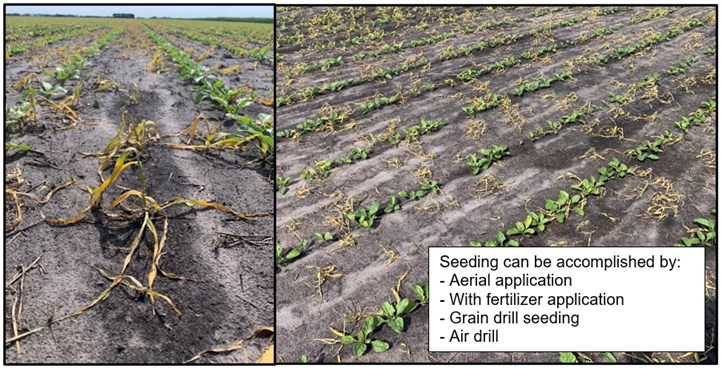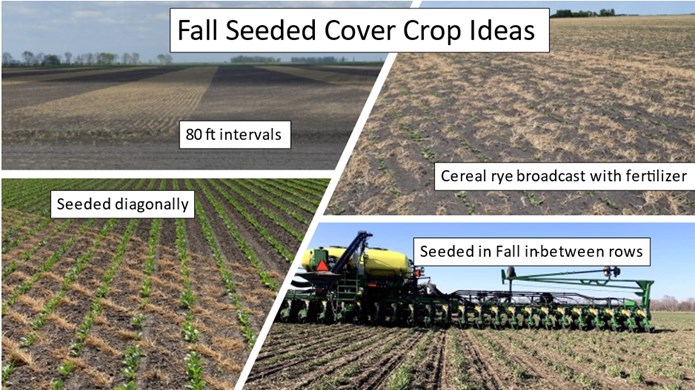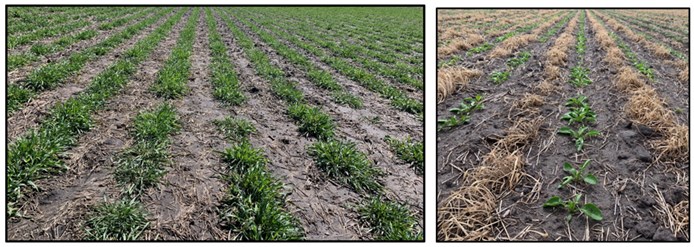626 - Cover Crop Protection from Wind Erosion
The wind events in June of 2022 were horrendous and at unprecedented levels moving soil, injuring sugarbeets, reducing stands and causing replants in an already late year. Cover crops are one of the only defenses available to protect the sugarbeet and soil from moving.
The below picture is of dead seedling sugarbeets from wind damage and soil movement from this past June.

The chart below is from American Crystal’s grower production data base showing the 5 year average production and economic benefit of using a cover crop. This data represents both fall and spring seeded cover/nurse crops as a “cover crop”. On average there is a benefit of 243 lbs. of recoverable sugar/acre and $36/acre. However, the benefit can be even greater if extreme stand loss and replanting is avoided by using a cover crop. Replanting creates extra production costs along with decreased yield potential.

In this Ag Note are some cover crop ideas from the ACSC Ag Staff and from Dr. Tom Peters on the research he has done.
We typically use the term “cover crop” interchangeably for fall & spring seeded cover crops; however, they can be categorized two ways:
Cover crop: Seeded and established in the fall and overwinters until the following spring and is present as the crop is planted.
Nurse crop: Seeded in the spring and establishes as a companion crop with the main crop.
Spring Seeded Nurse Crop
We are very familiar with seeding barley, wheat, or oats at about a ½ bushel/acre in the spring with sugarbeets for protection against high winds. This is a great practice and has been done for years and is highly encouraged.

Terminate the nurse crop before it starts competing with the sugarbeet, the carcass of the plant will still provide protection
- For spring seeded nurse crops, terminate when the nurse crop is at the 3-4 leaf stage
Preemerge herbicide applications and spring seeded nurse crops:
This can be tricky as preemerge herbicides may reduce the spring seeded nurse crop’s stand as it must emerge through it.
One must decide what is of greatest need in the field when weighing the risks and rewards of spring nurse crops and preemerge herbicides. Is it weed control or wind protection?
Giving the nurse crop a head start in germinating in the spring is a way to overcome this to some extent.
- Seed the nurse crop two or three days ahead of seeding the sugarbeets and the pre-emergence herbicide application
- This is especially important if rain is in the forecast that will incorporate the preemerge herbicide
- Increase the seeding rate of the cover crop to account for damage from preemergence herbicide
Spring seeded nurse crops safety to preemerge herbicides:
- Dual Magnum at 0.5 – 0.75 pt./acre: generally safe for nurse crops.
- Dual Magnum at 0.5 pt/acre + ethofumesate at 2–3 pt/acre: generally safe to nurse crops but more injurious than Dual Magnum alone
- Ethofumesate at 3.0 – 4.5 pt./acre: may reduce nurse crop stands
- Ethofumesate at 5.0 – 7.5 pt./acre: may cause significant injury to nurse crops
Fall Seeded Cover Crop
There is an advantage to having a fall-seeded cover crop as it is already in-place and established in the spring right as sugarbeets are being planted. Winter wheat and rye can be great options for this.
Below are some fall seeded cover crop examples:

Thoughts and Tips on Fall Cover Crops
- What to plant for a fall cover crop: Winter/Cereal Rye or Winter Wheat
- Seeding rates to use:
- Broadcast seeding rate is 10-17 lbs./acre
- Banding in row seeding rate is 3-5 lbs./acre
- Seed before September 15th so the fall cover crop can get established. Later dates can work but weather conducive for cover crop establishment is the main concern.
- Fertilizer: To avoid nitrogen loss, fall nitrogen fertilizer applications ideally should not occur until after October 1st and when soil temperatures at a 4” depth are 50°F or less. Establishing a fall cover crop is done earlier than what is the ideal timing for fall nitrogen fertilizer applications as it is too warm.
- Consider using a N-stabilizer to prevent nitrification, denitrification, ammonia volatilization, or urease production. There are 3 major categories:
- Nitrification inhibitors – used mainly in the fall
- Slow-release ESN coated fertilizer – used mainly in the fall
- Urease inhibitors – used mainly in the spring
- Consider timing a broadcast nitrogen application later in the fall or spring timed ahead of a rain event to incorporate it
- Side dressing in the growing season is an option well
- Consider using a N-stabilizer to prevent nitrification, denitrification, ammonia volatilization, or urease production. There are 3 major categories:
- Preemerge herbicides & fall seeded cover crops: The preemerge herbicides (any of the options described above) should not affect the fall cover crop since the fall cover crop is already established
- Terminate the cover crop before it starts competing with the sugarbeet, the carcass of the plant will still provide protection
- For fall cover crop, terminate in the spring before planting or very shortly after
- Rye can grow very aggressively, be sure to actively manage it
- For fall cover crop, terminate in the spring before planting or very shortly after
Banding rye in-between sugarbeet rows: This another idea that has been done in the fall and is a very controlled cover crop placement in the off-set rows. It reduces competition with sugarbeet in the spring while still protecting the seedling. However, it does require a bit more time in field preparation.
Common ways this has been accomplished is by:
- Preparing the field and planting the cover crop with a row crop planter
- When ridging a field, seed cover crop with a Gandy unit in-between the rows

Pre-Piled Sugarbeet Fields – consider planting a cover crop!
Planting a cover crop in August & September, even if just on headlands and in opening splits, can go a long way in protecting a field from wind erosion over the winter/early spring. This can be seeded after pre-pile and tilled in, or aerial applied over the canopy to be incorporated by the activity of harvest.
